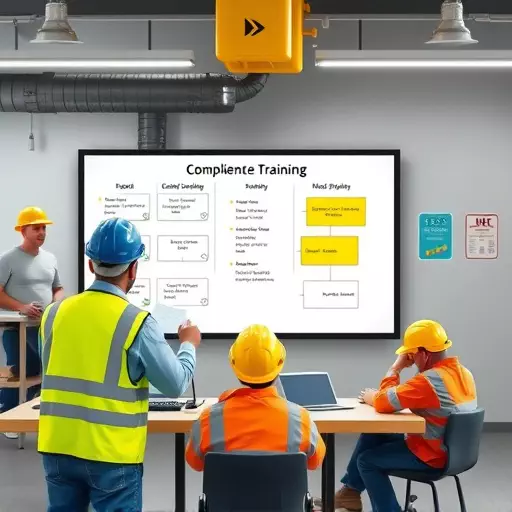Workplace violence prevention requires a multi-faceted approach. Organizations must conduct risk assessments, identify triggers, and implement proactive measures like comprehensive training programs. Key elements include stress management, conflict resolution, de-escalation techniques, and interactive sessions on handling aggression. Effective communication, open dialogue, and role-play scenarios enhance safety. Compliance training scheduling tools streamline occupational safety training, ensuring timely updates and recertifications. By fostering open communication, regular training, and utilizing these tools, organizations can create a safer, more supportive work environment, reducing the risk of violence. Measuring success through assessments, simulations, and feedback ensures ongoing improvement in workplace violence prevention strategies.
Workplace violence is a serious issue that demands proactive measures to ensure employee safety. This comprehensive guide delves into essential aspects of preventing workplace violence through targeted training. We explore strategies for identifying risks and triggers, designing effective curriculum, implementing communication tactics, leveraging technology in compliance training scheduling, fostering a supportive environment, and measuring the success of these initiatives. By integrating these elements into your environmental health and safety training planning, you can significantly enhance occupational safety through comprehensive training programs.
- Understanding Workplace Violence: Identifying Risks and Triggers
- Creating a Comprehensive Training Curriculum: What to Include?
- Implementing Effective Communication Strategies for Prevention
- Utilizing Technology: Compliance Training Scheduling Tools
- Fostering a Safe Environment: Role of Managers and Colleagues
- Measuring Success: Evaluating the Impact of Workplace Violence Prevention Training
Understanding Workplace Violence: Identifying Risks and Triggers

Workplace violence can manifest in various forms, from verbal abuse and threats to physical assaults, and understanding these different types is a critical first step. It’s essential for organizations to conduct thorough risk assessments to identify potential triggers within their unique work environments. These risks might stem from factors like workplace stress, power imbalances, or past conflicts. By recognizing signs of escalating tension or identifying individuals at higher risk due to their role or personal circumstances, employers can take proactive measures.
Effective prevention strategies often involve comprehensive training programs that educate employees on recognizing and responding to potentially violent situations. Environmental health and safety training should incorporate scenarios and discussions around stress management, conflict resolution, and de-escalation techniques. Compliance training scheduling tools can be utilized to ensure all staff receive this critical occupational safety training promptly, fostering a safer and more supportive work atmosphere.
Creating a Comprehensive Training Curriculum: What to Include?

A comprehensive workplace violence prevention training curriculum should be meticulously designed to cover various aspects that contribute to a safe and respectful work environment. This includes interactive sessions on identifying and addressing verbal, physical, and psychological aggression. Facilitators can use real-life scenarios to engage participants, allowing them to practice de-escalation techniques and learn appropriate responses to different situations.
The curriculum must also incorporate elements of environmental health and safety training planning, such as understanding workplace stressors, recognizing potential triggers for violence, and promoting positive communication channels. Occupational safety training programs can be enhanced by including topics like conflict resolution, emotional intelligence, and the importance of a diverse and inclusive workforce. Compliance training scheduling tools can help organizations stay on top of regular updates and ensure that all employees receive timely recertifications.
Implementing Effective Communication Strategies for Prevention

Effective communication is a cornerstone in preventing workplace violence. It involves creating an open and transparent environment where employees feel comfortable expressing concerns, reporting incidents, and participating in discussions related to safety. As part of environmental health and safety training planning, organizations should incorporate interactive workshops or role-play scenarios that simulate potential violent situations. These activities encourage employees to practice assertive communication techniques, fostering a culture of respect and de-escalation.
Occupational safety training programs can benefit from integrating strategies that promote active listening, clear and concise messaging, and empathy. Compliance training scheduling tools can be utilized to ensure regular refresher courses, making it easier for managers and HR departments to track participation and identify areas where additional support or personalized coaching might be required. By emphasizing open communication, organizations can create a safer, more supportive work environment that minimizes the risk of violent incidents.
Utilizing Technology: Compliance Training Scheduling Tools

In today’s digital era, compliance training scheduling tools have become indispensable for effective environmental health and safety training planning. These innovative platforms streamline the process of organizing and delivering critical occupational safety training programs. By leveraging technology, organizations can ensure that all employees access essential training materials at their convenience, promoting a culture of continuous learning and safety awareness.
Through centralized databases and automated scheduling, compliance training tools enhance efficiency in managing diverse training modules. This not only saves time but also guarantees adherence to regulatory requirements. With real-time tracking capabilities, these tools enable managers to monitor employee progress, identify knowledge gaps, and promptly address them, thereby fostering a safer and more informed workplace environment.
Fostering a Safe Environment: Role of Managers and Colleagues

Creating a safe and respectful workplace environment is a collective responsibility that starts at the top with managers and leaders. Managers play a pivotal role in fostering a culture where every employee feels valued, heard, and secure. They should actively promote open communication, ensuring that employees feel comfortable reporting any instances of harassment or violence without fear of retaliation. Regularly conducting environmental health and safety training sessions, including specific modules on preventing workplace violence, can empower staff to recognize potential hazards and take proactive measures.
Colleagues also have a crucial part to play in maintaining a safe space. Encouraging a ‘no-tolerance’ policy for violent or aggressive behavior and quickly reporting any concerning incidents can help identify and resolve issues before they escalate. Effective occupational safety training programs, coupled with compliance training scheduling tools, enable efficient tracking of employee participation and knowledge retention, ensuring everyone is up to speed on their responsibilities in creating and sustaining a safe working environment.
Measuring Success: Evaluating the Impact of Workplace Violence Prevention Training

Measuring the success of Workplace Violence Prevention Training (WVPT) is crucial for evaluating its effectiveness and ensuring a safe work environment. It involves assessing whether the training has achieved its intended goals, raised awareness, and empowered employees to handle potential violent situations. One way to gauge success is through post-training assessments, which can include knowledge tests, scenario simulations, or feedback forms. These tools help identify areas of improvement and reinforce learning outcomes.
Moreover, tracking participation rates and employee satisfaction with the training sessions is essential. Compliance training scheduling tools can facilitate this process by enabling organizations to record attendance, monitor progress, and gain insights into employee engagement. Over time, regular evaluations and data analysis will reveal the impact of WVPT on the overall work environment, helping environmental health and safety teams adapt their strategies and ensure ongoing compliance with occupational safety training programs.


